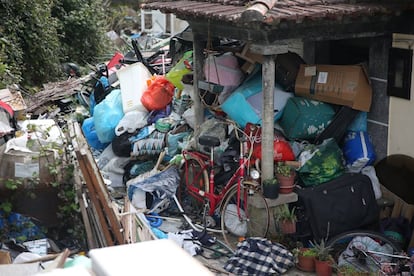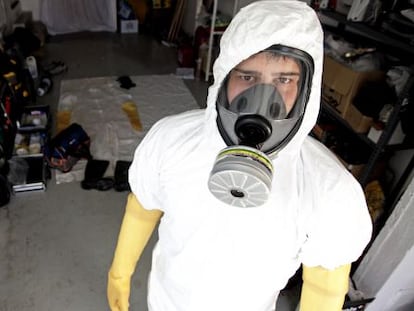The lonely people buried in graves of garbage
Authorities in Vigo recently found the body of a man with Diogenes Syndrome who was reported missing by a Facebook friend

It was one of José Ángel’s 3,544 friends from the social networks who phoned the police in Vigo, Galicia, to report the 51-year-old’s absence from Facebook and WhatsApp. Acquainted only with his online persona, the woman was unaware he lived under a mountain of garbage that he added to every evening after making his rounds of the local dumpsters; nor that his home was so stuffed with trash that he had to climb in and out of it through a window.
The story was widely reported in the northwestern port city, but no one has claimed his body. The local authorities gave him a paupers’ funeral, and the only trace of his existence is a Facebook page and a small cross in the Pereiró cemetery with the number 113 on it.
The authorities in Madrid receive around 300 complaints a year about people hoarding trash in their homes
José Ángel suffered from what is known as Diogenes Syndrome, a condition that drives people to compulsively hoard garbage. Last January, a 62-year-old man from Asturias, along with an 84-year-old woman in Cáceres, were found in similar circumstances. At the beginning of this month, emergency services were called out to the home of a 79-year-old woman in Erandio, near Bilbao, who they assumed to be dead due to the stench from inside the property, although she died just minutes after they arrived. What made José Ángel, 51, different to other sufferers was his online activity.
Of the handful of people with DS who are found dead each year in Spain, some die of starvation or illness, while others are sometimes buried alive when the garbage they amass collapses on top of them. In winter, it is not unusual for sufferers to light cardboard and wooden boxes in an effort to keep warm, sometimes setting off fires in their homes.
Typically isolated, most sufferers are not found for days or weeks after their death, and sometimes the authorities are only alerted months later.
This can make it hard to identify bodies, which will often be in an advanced state of decomposition. In 2012, a 70-year-old woman was found in A Coruña two months after her death, partially eaten by rats.
Sign up for our newsletter
EL PAÍS English Edition is launching a weekly newsletter. Sign up today to receive a selection of our best stories in your inbox every Saturday morning. For full details about how to subscribe, click here.
In most cases, overstretched social workers are aware of people in the community with DS, but admit they are able to do little to help sufferers or to provide practical assistance to neighbors who must put up with the hygiene problems sufferers can create.
According to the Madrid College of Property Administrators, 60% of inquiries by residents’ associations are about what to do with neighbors with DS: the authorities in Madrid receive around 300 complaints a year about people hoarding trash in their homes.
In 2010, the authorities in Almería entered 34 homes filled with refuse, while four DS sufferers died after being admitted to hospital. A 57-year-old man from Málaga died in hospital the same year after being rescued from his burning home. The local council had failed to have him admitted to a psychiatric unit, although it was able to empty the apartment and repaint it, however, within a few years he had filled it again.
DS sufferers who start fires to keep warm pose grave problems for their neighbors. In March last year, a 51-year-old DS sufferer set a building in Palma ablaze, which took firefighters five hours to put out. Most sufferers live alone and have no family contact. Psychiatrists say they typically have low self-esteem and they live in a state of perpetual self-neglect.
In some extreme cases, DS sufferers hoard pets as well as trash. In the small town of Rianxo, in A Coruña, the local authorities waded through tons of refuse to rescue two elderly women and 140 sick dogs, more than half of which had to be put down.
One of the women lived in a bed with the animals piled in beside her. The other woman was blind and was still waiting for some form of support she was entitled to by law years later.
English version by Heather Galloway.
“We’re seeing more and more of this”
Psychiatrist Luis Ferrer explains that Diogenes Syndrome is the symptom of mental disorders that can affect both men and women, and that it usually develops later in life.
“People with Diogenes Syndrome have a tendency to depression which is exacerbated by loneliness. They relieve feelings of emptiness with objects”, he says, adding that there is often a traumatic event in their past that triggers their behavior. Most sufferers are unable to hold down work and also have a tendency to drink, he adds. The compulsive obsessive traits that define DS sufferers often manifest themselves in adolescence, but “over the years, these traits grow more pronounced,” explains Ferrer, partly because “the elderly tend to spend more time alone and suffer from anxiety.”
José Ángel’s Facebook activity caught the attention of psychiatrists because, according to Ferrer, “this is something we might see more of in the future as our tendency to inhabit the so-called ‘third environment’ grows”, he says, in reference to the virtual world many people who live alone inhabit.
José Manuel Menchón, head of the Bellvitge Psychiatric Hospital in Barcelona, explains that some DS sufferers may find “a release from their inhibitions” on the internet, but all DS sufferers reject help from their neighbors. The syndrome means they would rather die taking refuge in their refuse-filled homes than go to hospital. “Their self-neglect,” says Menchón, makes this inevitable.
There is little statistical data, but Menchón believes it affects around 2,000 every year in Spain.
Sufferers of DS are typically unaware of their condition and do not seek medical help. In certain cases, they have managed to persuade their partner or a member of their family to enter into the same compulsive behavior. In general, the medical community links the syndrome to alcoholism, senility or schizophrenia, while some specialists have suggested it could be triggered by damage to the frontal lobe of the brain.
Tu suscripción se está usando en otro dispositivo
¿Quieres añadir otro usuario a tu suscripción?
Si continúas leyendo en este dispositivo, no se podrá leer en el otro.
FlechaTu suscripción se está usando en otro dispositivo y solo puedes acceder a EL PAÍS desde un dispositivo a la vez.
Si quieres compartir tu cuenta, cambia tu suscripción a la modalidad Premium, así podrás añadir otro usuario. Cada uno accederá con su propia cuenta de email, lo que os permitirá personalizar vuestra experiencia en EL PAÍS.
¿Tienes una suscripción de empresa? Accede aquí para contratar más cuentas.
En el caso de no saber quién está usando tu cuenta, te recomendamos cambiar tu contraseña aquí.
Si decides continuar compartiendo tu cuenta, este mensaje se mostrará en tu dispositivo y en el de la otra persona que está usando tu cuenta de forma indefinida, afectando a tu experiencia de lectura. Puedes consultar aquí los términos y condiciones de la suscripción digital.
More information
Últimas noticias
Maduro pleads not guilty before the federal court in New York: ‘I am still the president of Venezuela’
A new test can detect Alzheimer’s from a finger prick
UN team enters Sudanese city of El Fasher after paramilitary massacre: ‘It’s like a ghost town’
A recipe for resistance: Indigenous peoples politicize their struggles from the kitchen
Most viewed
- Gilles Lipovetsky: ‘If you want to live better and fall in love, take Prozac, don’t look to philosophy’
- Alain Aspect, Nobel laureate in physics: ‘Einstein was so smart that he would have had to recognize quantum entanglement’
- Maduro’s downfall puts China’s relationship with Venezuela to the test
- Why oil has been at the center of Venezuela-US conflicts for decades
- Alvin Hellerstein, a 92-year-old judge appointed by Bill Clinton, to preside over Maduro’s trial in New York









































